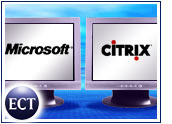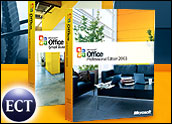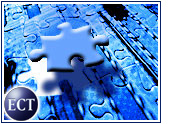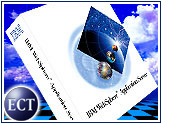
Even in the ever-changing technology world, companies that hold 80 percent market share typically can breathe easy. However, that is not the case at Citrix Systems. The maker of MetaFrame thin-client software, which lets PC users access applications that run remotely on servers, is seeing its long-standing cooperation with Microsoft turning into strong “coopetition.” Moreover, threats from smaller companies, such as Tarantella, are growing.
As it faces pressure from boutique developers on one side and Microsoft on the other, Citrix has begun launching complementary solutions to its core MetaFrame Presentation Server product. By solving common problems — from password management to workgroup collaboration — the company hopes to retain loyal customers that otherwise might be tempted by cost-effective Microsoft offerings.
Fat Market for Thin Clients
Citrix is starting out in a strong position. Claiming more than 120,000 customers and 50 million users, the company provides what it calls “access infrastructure.” Commonly referred to as thin-client software, these solutions require data and applications to reside on central servers, where they can be accessed by individual PCs.
This setup solves several problems for an IT department. Application upgrades can be performed more quickly because the software must be updated only on central servers, rather than on every PC in the company. Security also is enhanced, and data can be backed up more readily.
“We allow IT managers to free up the resources they use to manage deployments on a day-to-day basis,” said Brian Nason, director of product management for Citrix MetaFrame XP Presentation Server. “They can invest those dollars into other IT projects that are more beneficial to them. We are all dealing with zero-sum budgets these days, and this is one way we can free IT people to be of a greater value to their companies.”
Thin-client products often are implemented by firms with branch offices, remote workers or salespeople who spend a lot of time on the road. By connecting to the system’s servers from just about any computer, at any location, users can access their e-mail, data, documents and applications.
New Problems Solved
Citrix is not standing still amid competition. The company recently launched MetaFrame XP Presentation Server, Feature Release 3, for Windows, as well as MetaFrame Presentation Server 1.2 for Unix. Certified to run on Windows 2000 and Windows 2003 servers, the XP release gives administrators more control than previous versions, Nason told the E-Commerce Times. It also includes a universal print driver and browser acceleration, which can improve the user experience for interactive applications.
Perhaps even more interesting are the company’s new product offerings. Citrix MetaFrame Secure Access Manager provides access similar to a virtual private network, giving users browser-based, SSL-encrypted access to the entire enterprise. And MetaFrame Password Manager, set to launch later this quarter, lets users log on with a single password, rather than juggling separate usernames for each application.
Another product, Citrix MetaFrame Conferencing Manager, allows groups to work concurrently on the same applications and documents.
“We aren’t trying to compete with corporate meetings or online webinars,” Nason said. “And we aren’t trying to solve the world’s problems around real-time collaboration. This simply allows multiple people to interact with an application, like a spreadsheet. The tool optimizes the time that the team spends on the document.”
David vs. Goliath
When it comes time to choose a thin-client system, most buyers traditionally have not paid much attention to price, ease of use, or any of the hundreds of other features that typically play a part in such a decision.
Instead, the choice typically boils down to current IT infrastructure, according to David Friedlander, an analyst with Forrester Research. While Citrix usually comes out on top, there are exceptions.
“Users may look at Tarantella, or a combination of Tarantella and Citrix, if there are a significant number of non-Windows applications that need to be deployed,” Friedlander told the E-Commerce Times. “With Windows, the decision is almost always in Citrix’ favor. They effectively have a monopoly in that space with Microsoft, which developed the underlying platform. It is very difficult for a small vendor like Tarantella to compete with an established monopoly that is 20 to 30 times bigger.”
Lightweight Challenger
However, Tarantella does have some strengths. Its thin-client software runs on a dedicated remote server. This means that when network problems arise, IT staff often can solve them simply by taking the Tarantella server out of service, IDC vice president of system software Dan Kusnetzky told the E-Commerce Times. This allows them to determine whether the difficulty involves the server or the application software.
In June, Tarantella began shipping its New Moon Canaveral iQ v2.0 software, which is optimized for the Windows Server 2003 platform. Priced aggressively, the release can be purchased for less than US$100 per user.
However, even the competitive price might not give Tarantella much of an edge over Citrix when the two go head-to-head.
“If the features are similar, customers are more likely to go with the known, established and trusted vendor,” Friedlander said. “If prices are higher for [Citrix] software, it’s not necessarily that big of a hit for the buyer. The more important costs are those for implementation and ongoing support.”
Heavyweight Division
However, despite Citrix’ lopsided advantage against smaller vendors, with the release of Microsoft Windows Server 2003, it saw the opening salvo in what might become a war for the thin-client market. This Windows release added new networking and communications functionality intended to improve employee remote access to corporate computing resources.
“With the 2003 server, the terminal has gotten quite a bit more intelligent,” Kusnetzky noted. “It now does many of the same things that [Citrix] Presentation server does.”
In fact, if all user applications are Windows-based, and all client devices also are Windows-based, Microsoft is probably the better choice, he said.
“Microsoft routinely works with a partner to some point and then decides that their functionality would be better within the Microsoft operating system,” he added. “Even though they are very good partners today, Citrix will increasingly find itself challenged by Microsoft.”






















































For those who read this article in 2008 and beyond, if you are looking for an alternative to Citrix, take a look at Ericom Software (www.ericom.com). Their PowerTerm WebConnect offers many compelling features that enhance Terminal Services: seamless windows, application publishing by groups, load balancing, etc. It is also certified to work with Windows 2008 Terminal Server.
Why not an OSX thin client for x86? Turn all those Wintel PC’s found on businesses’ desktops into productivity enhancers by running Office:X off of racks of Xserves.
–
With unlimited seats for $999, consider the savings for a company with 5000 Office users. Darwin (already running on x86) could be the basis for this thin client.